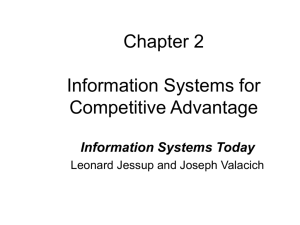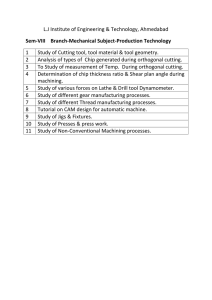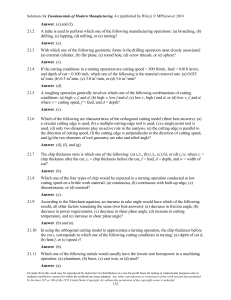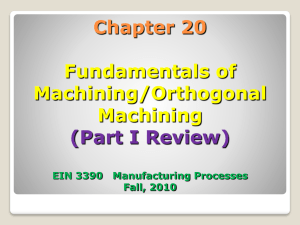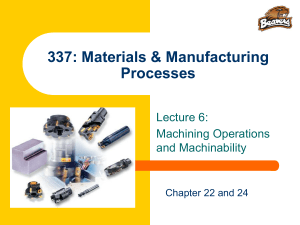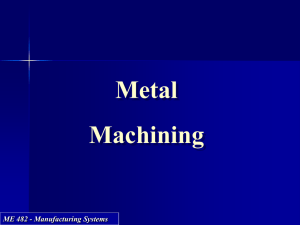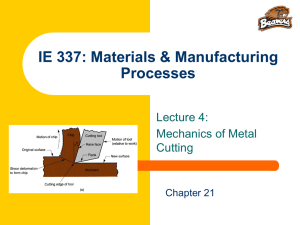Chapter 20 THEORY OF METAL MACHINING
advertisement
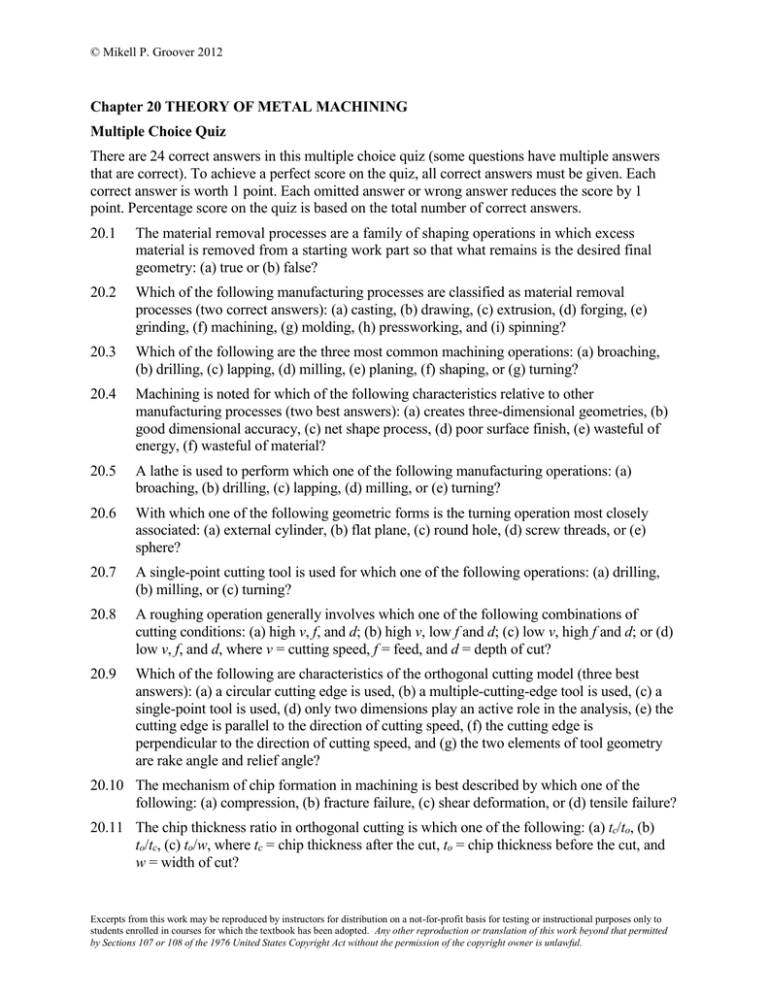
© Mikell P. Groover 2012 Chapter 20 THEORY OF METAL MACHINING Multiple Choice Quiz There are 24 correct answers in this multiple choice quiz (some questions have multiple answers that are correct). To achieve a perfect score on the quiz, all correct answers must be given. Each correct answer is worth 1 point. Each omitted answer or wrong answer reduces the score by 1 point. Percentage score on the quiz is based on the total number of correct answers. 20.1 The material removal processes are a family of shaping operations in which excess material is removed from a starting work part so that what remains is the desired final geometry: (a) true or (b) false? 20.2 Which of the following manufacturing processes are classified as material removal processes (two correct answers): (a) casting, (b) drawing, (c) extrusion, (d) forging, (e) grinding, (f) machining, (g) molding, (h) pressworking, and (i) spinning? 20.3 Which of the following are the three most common machining operations: (a) broaching, (b) drilling, (c) lapping, (d) milling, (e) planing, (f) shaping, or (g) turning? 20.4 Machining is noted for which of the following characteristics relative to other manufacturing processes (two best answers): (a) creates three-dimensional geometries, (b) good dimensional accuracy, (c) net shape process, (d) poor surface finish, (e) wasteful of energy, (f) wasteful of material? 20.5 A lathe is used to perform which one of the following manufacturing operations: (a) broaching, (b) drilling, (c) lapping, (d) milling, or (e) turning? 20.6 With which one of the following geometric forms is the turning operation most closely associated: (a) external cylinder, (b) flat plane, (c) round hole, (d) screw threads, or (e) sphere? 20.7 A single-point cutting tool is used for which one of the following operations: (a) drilling, (b) milling, or (c) turning? 20.8 A roughing operation generally involves which one of the following combinations of cutting conditions: (a) high v, f, and d; (b) high v, low f and d; (c) low v, high f and d; or (d) low v, f, and d, where v = cutting speed, f = feed, and d = depth of cut? 20.9 Which of the following are characteristics of the orthogonal cutting model (three best answers): (a) a circular cutting edge is used, (b) a multiple-cutting-edge tool is used, (c) a single-point tool is used, (d) only two dimensions play an active role in the analysis, (e) the cutting edge is parallel to the direction of cutting speed, (f) the cutting edge is perpendicular to the direction of cutting speed, and (g) the two elements of tool geometry are rake angle and relief angle? 20.10 The mechanism of chip formation in machining is best described by which one of the following: (a) compression, (b) fracture failure, (c) shear deformation, or (d) tensile failure? 20.11 The chip thickness ratio in orthogonal cutting is which one of the following: (a) tc/to, (b) to/tc, (c) to/w, where tc = chip thickness after the cut, to = chip thickness before the cut, and w = width of cut? Excerpts from this work may be reproduced by instructors for distribution on a not-for-profit basis for testing or instructional purposes only to students enrolled in courses for which the textbook has been adopted. Any other reproduction or translation of this work beyond that permitted by Sections 107 or 108 of the 1976 United States Copyright Act without the permission of the copyright owner is unlawful. © Mikell P. Groover 2012 20.12 Which one of the four types of chip would be expected in a turning operation conducted at low cutting speed on a brittle work material: (a) continuous, (b) continuous with built-up edge, (c) discontinuous, or (d) serrated? 20.13 According to the Merchant equation, an increase in rake angle would have which of the following results, all other factors remaining the same (two best answers): (a) decrease in friction angle, (b) decrease in power requirements, (c) decrease in shear plane angle, (d) increase in cutting temperature, and (e) increase in shear plane angle? 20.14 In using the orthogonal cutting model to approximate a turning operation, the chip thickness before the cut to corresponds to which one of the following cutting conditions in turning: (a) depth of cut d, (b) feed f, or (c) speed v? 20.15 Specific energy in metal machining is a measure of the amount of energy required to remove a unit volume of material: (a) true or (b) false? 20.16 Which one of the following metals would usually have the lowest specific energy in a machining operation: (a) aluminum, (b) brass, (c) cast iron, or (d) steel? 20.17 Which one of the following cutting conditions has the strongest effect on cutting temperature: (a) cutting speed, (b) depth of cut, or (b) feed? Excerpts from this work may be reproduced by instructors for distribution on a not-for-profit basis for testing or instructional purposes only to students enrolled in courses for which the textbook has been adopted. Any other reproduction or translation of this work beyond that permitted by Sections 107 or 108 of the 1976 United States Copyright Act without the permission of the copyright owner is unlawful.





